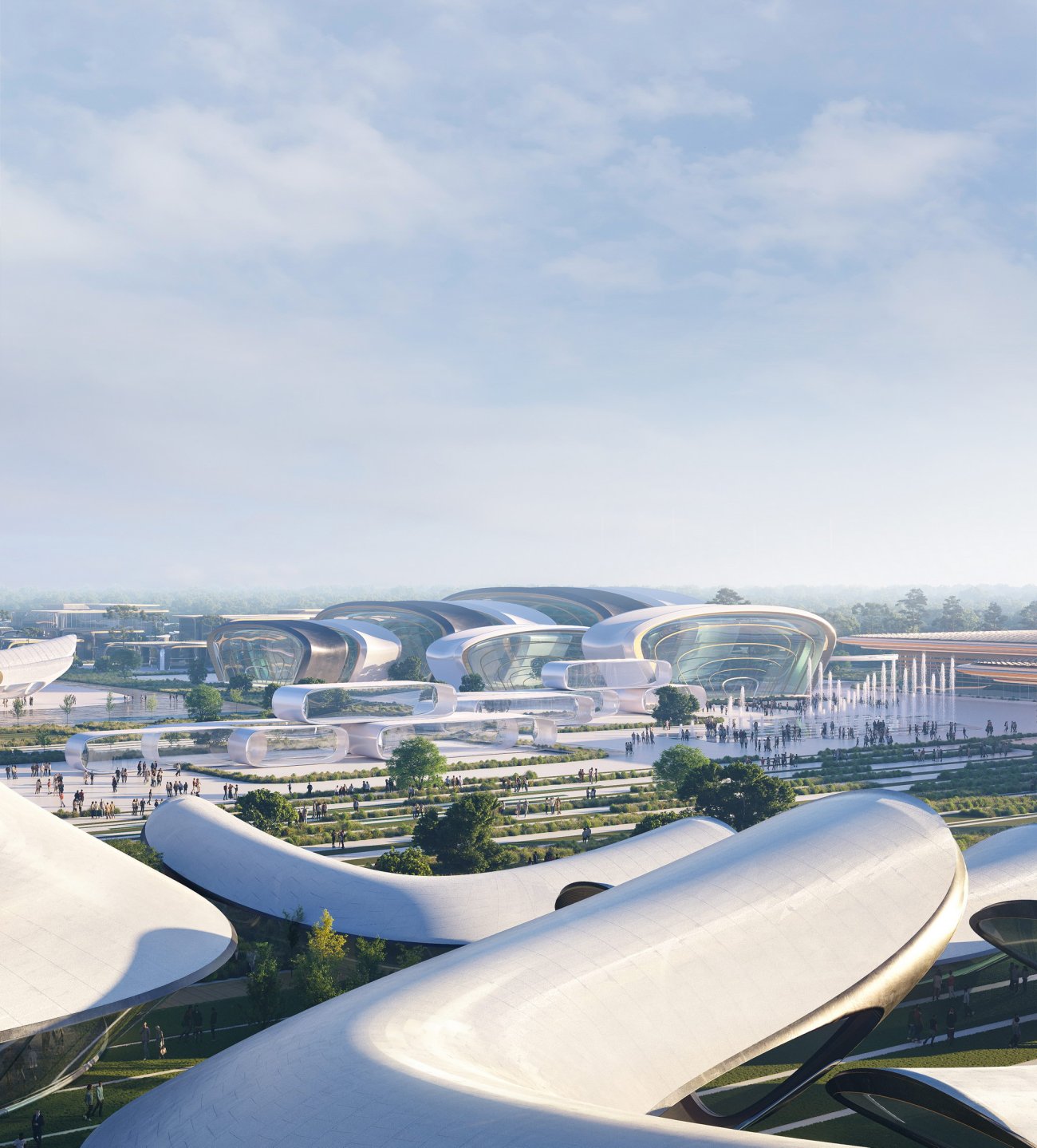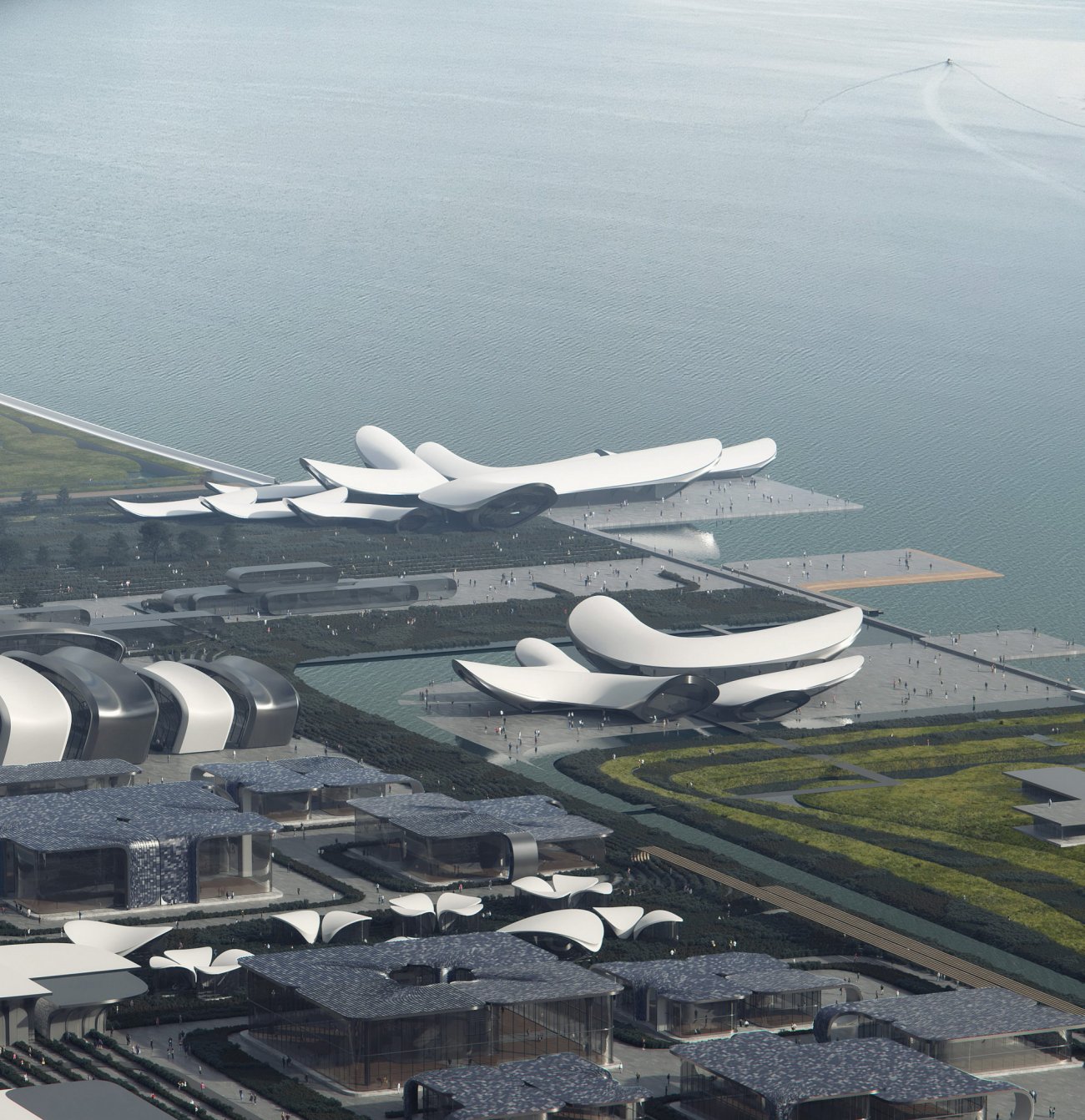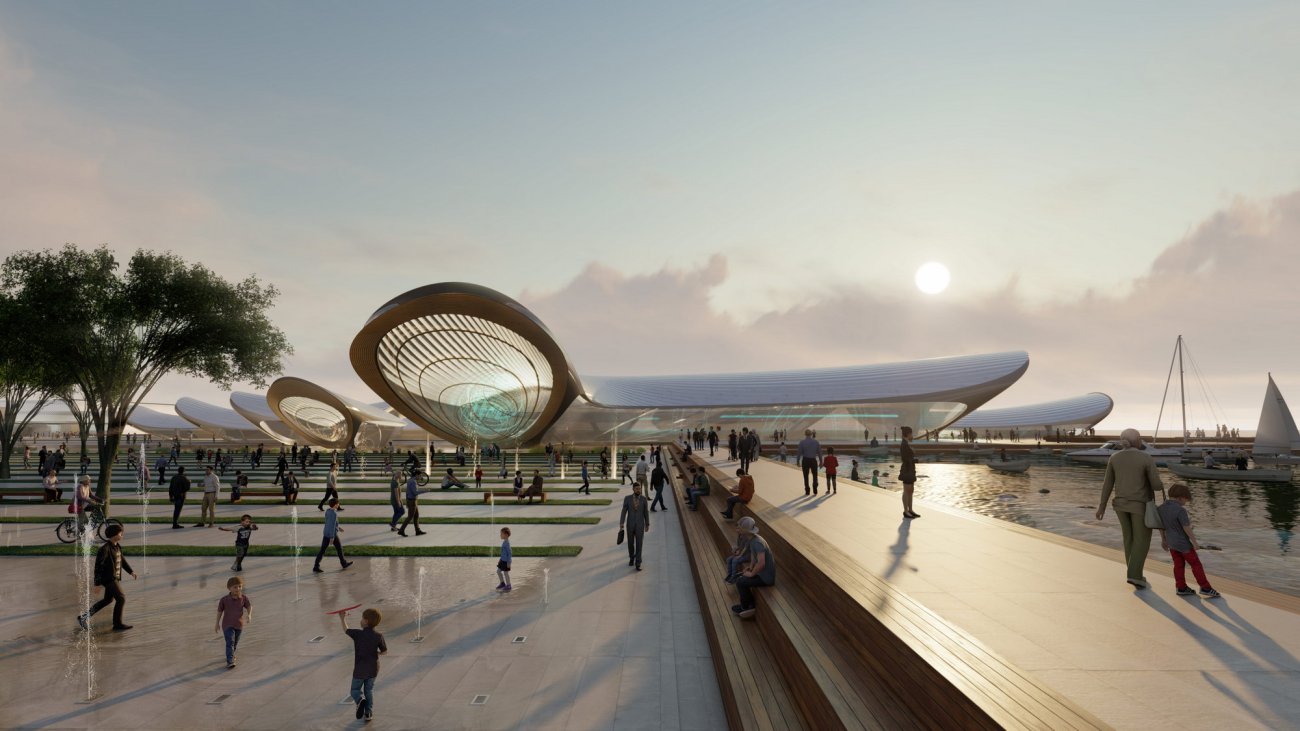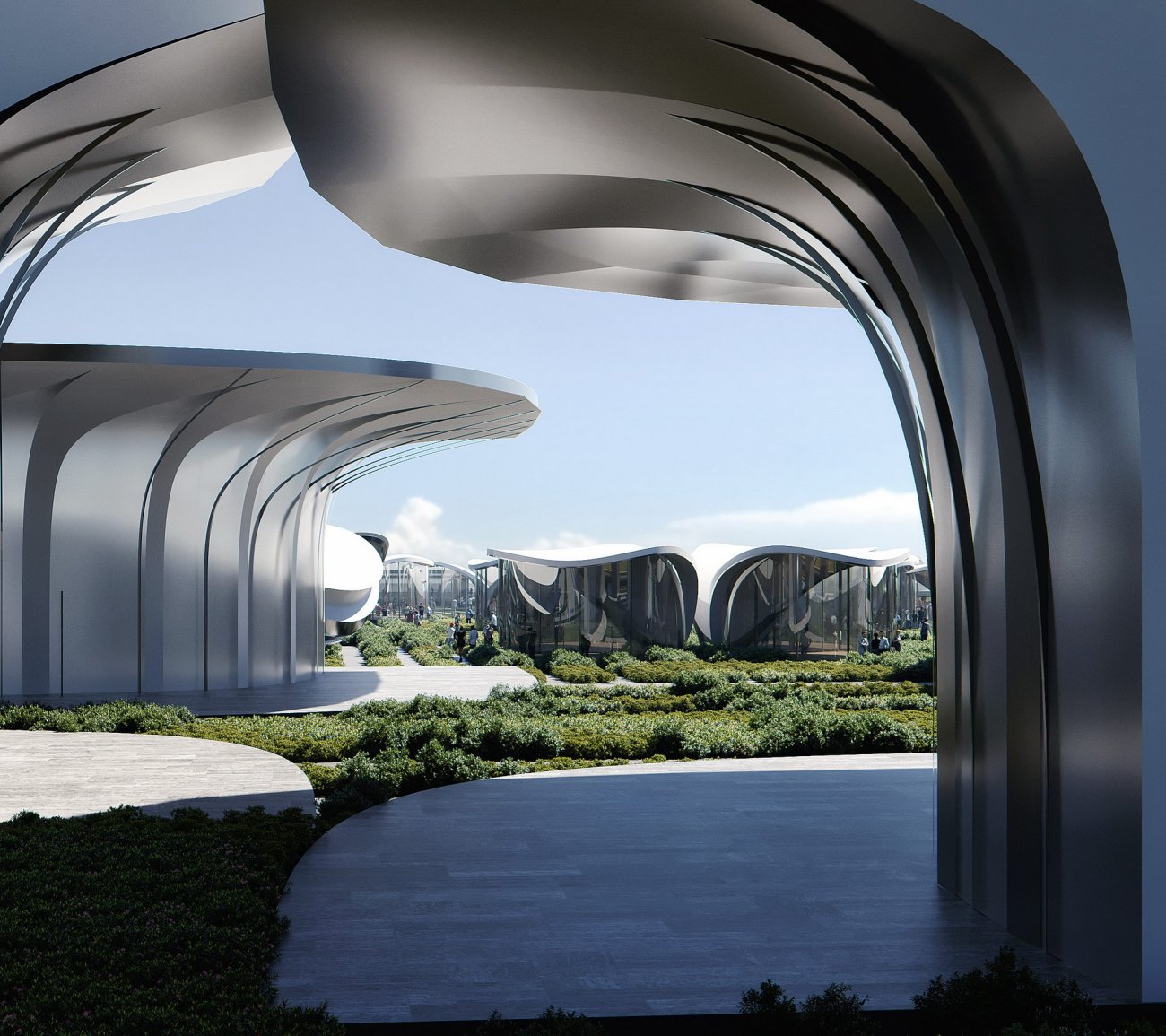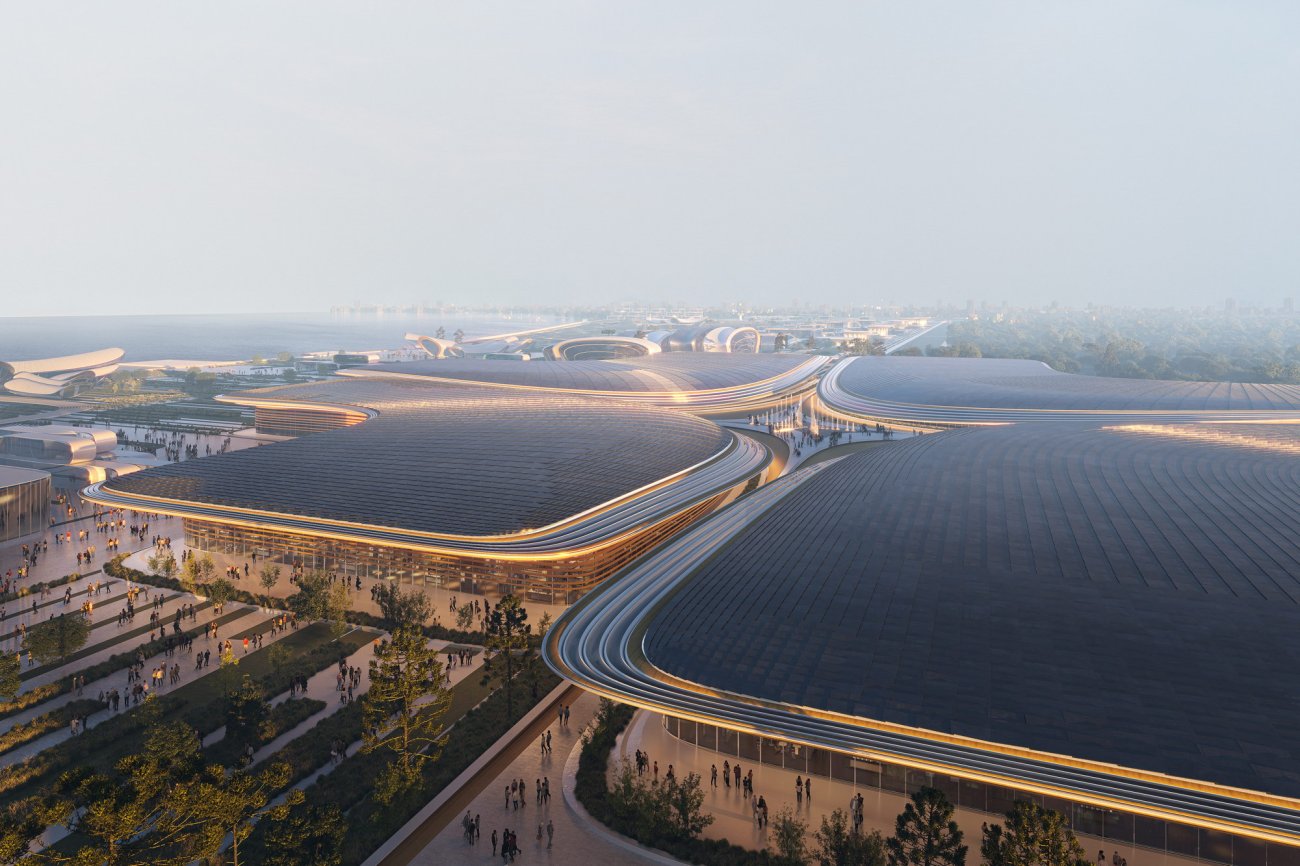| 公司: | 扎哈·哈迪德建筑事务所 | 类型: | 建筑 |
|---|---|---|---|
| 地区: | 乌克兰 | 标签: | 文化空间 |
“它是一个有着悠久历史和多元文化的城市,在2030年世博会期间当你来到乌克兰的敖德萨,你将感受到的不仅仅是一个国家和城市文明力量……你将感受到全人类的潜力。”乌克兰总统沃洛季米尔·泽连斯基
“In a city that has always been multinational and multicultural, a city of diversity with ancient connections throughout the world, when you visit Ukraine and our Odesa in 2030, you will feel the power and culture of not just one country and one city… you will feel the potential of all humanity.” Volodymyr Zelenskyy, President of Ukraine
▽鸟瞰图
扎哈·哈迪德建筑事务所加入乌克兰敖德萨的代表团,参加了在巴黎举行的第171届国际展览局(BIE)大会,提出了2030年敖德萨世博会的竞标提案。
Zaha Hadid Architects joined the delegation representing Odesa, Ukraine at the 171st General Assembly of the Bureau International des Expositions (BIE) in Paris to present the ODESA EXPO 2030 bid proposal.
▽鸟瞰图
乌克兰未来的国家经济发展将会向能源效率和低碳技术发展。扎哈·哈迪德建筑事务所为2030年敖德萨世博会设计的目标是所有东西的有效再利用,这是所有世博会都面临的挑战和目标;在未来创造一个没有任何浪费的世博会。2030年敖德萨世博会是首次在东欧举办的世博会,《2030年可持续发展议程》由联合国通过面向经济和社会可持续性,实施提高效率和解决能源问题的战略,同时提高教育水平,促进整个地区的经济增长。
Future development in Ukraine will see a fundamental transformation of the country’s economy towards energy efficiency and low-carbon technologies. Zaha Hadid Architects’ design for ODESA EXPO 2030 targets the effective re-use of all facilities after the exhibition has closed, a challenge that all Expos share with major public events the world over; creating an Expo of the future where nothing is wasted.ODESA EXPO 2030 - the first Expo to be hosted in Eastern Europe - will follow the ‘2030 Agenda for Sustainable Development’ adopted by the United Nations to embrace economic and social sustainability, implement strategies that tackle energy efficiency and reduce the consumption of resources while improving education and encouraging economic growth throughout the region.
▽园区效果图
2030年敖德萨世博会的场地在靠近市中心的Khadzhibey河口,以前是具有生物多样性的集体耕作土地。独一无二的地理位置确保了2030年世博会的交通便利,并能充分融入城市交通基础设施和社区文化生活。游客从敖德萨的火车站或机场25分钟就能到达世博园区,从渡口出发仅需15分钟。敖德萨历史悠久的老城区和博物馆距离这里只有20分钟的路程。而从世博园到达多处海滩,仅15-30分钟的车程。
The site for ODESA EXPO 2030 was previously intensively-farmed land lacking in biodiversity on the Khadzhibey estuary. Near the centre of the city, this unique location ensures EXPO 2030 is easily accessible and can be fully integrated within the city’s transport infrastructure, community and cultural life.Visitors to Odesa can reach the EXPO site in 25 minutes from the city's airport or railway station, and in just 15 minutes from its ferry port. Odesa’s historic old town and museums are only 20 minutes from the site while the city’s variety of beaches are between 15 and 30 minutes away.
▽园区与河口
2030年敖德萨世博会将围绕五个主要元素展开。连接了世博会所有区域的主干道,主干道以南的一系列国家馆和广场,主干道以北Khadzhibey河口的新海岸生态公园 。访客、参会者和工作人员的服务、后勤和住宿都位于主干道的两端。
The EXPO 2030 site is organized around five main elements. The Main Boulevard connects all areas of the EXPO, with a series of plazas with national pavilions to the south of the boulevard and the new coastal eco-park on the Khadzhibey estuary to the north. Services, logistics and accommodation for visitors, participants, and staff are located at either end of the main boulevard.
▽主干道鸟瞰图
2030年敖德萨世博会的设计首先考虑到以后。总体规划围绕着四个中央展馆,这些大型展馆约8万平方公里。世博会结束后,毗邻世博会会议中心和酒店的灵活展厅,将成为乌克兰南部的第一个博览会展览中心。世博会之后,国家馆将被拆除并作为新的市政建筑重新部署在乌克兰各地,从而使整个世博会场地周围的新会议中心和展厅回归自然。并重新建造湿地,使其融入市中心附件的沿海生态公园。
ODESA EXPO 2030 is designed first and foremost with legacy in mind. The masterplan is focused around a cluster of four central pavilions. After the Expo, these large pavilions have been designed to provide 80,000 sq. m of flexible exhibition halls for trade fairs and events adjacent to the Expo’s conference centre and hotel to become southern Ukraine’s first fair exhibition hub.Following EXPO 2030, the national pavilions have been designed to be dismantled and redeployed as new civic buildings throughout Ukraine – allowing the entire Expo site surrounding the new conference centre and exhibition halls to be returned to nature with re-established wetlands integrated into this new coastal eco park near the city centre.
▽中央展馆
以前世博会国家馆的设计和建造采用的定制方法,经常导致建设成本和时间增加,加上更高的碳污染和未来很低的利用率。为了解决这些问题,2030年敖德萨世博会将为参会国家提供选择一套部件来建造他们的展馆。这种灵活的模块化系统将为参会国提供许多不同的选择,采用实用,创意和游客友好的原则设计他们的展馆,让每个国家都能通过各自独特的文化表达,来重新诠释2030年世博会的主题。每个组合组件约占标准展馆占地面积(1600平方英尺)的25%,也可以结合其他各种模块元素,创造每个国家所需要的展区面积。通过数字配置工具,参会国家将能自由选择组件以形成他们的展馆,并选择尽可能低碳的材料来设计定制立面。
The bespoke approach to designing and constructing national pavilions of previous Expos has often resulted in significantly increased construction costs and time,together with higher embedded carbon and reduced flexibility for any future use.Addressing these issues, ODESA EXPO 2030 will offer the participating nations the choice of a kit-of-parts to construct their pavilions.This flexible modular system will provide participating nations many varying options to design their pavilion using practical, creative and visitor-friendly principles that enable each nation to individually reinterpret the over-arching theme of EXPO 2030 via their country’s unique cultural expression. Each modular component will consist of approximately 25% of a standard pavilion’s 1,600 sq. m footprint and can be combined with a variety of other modular elements to create each country’s desired exhibition area.Via a digital configurator tool, participating countries will be able to select and connect components to form their pavilion and customize the façade design choosing amongst a set of material options with the lowest possible carbon impact.
▽国家展馆
世博会闭幕后,参与者们可以选择把展馆模块运送回他们的祖国,或者把它们捐赠给乌克兰各地,重新组装用作幼儿园、学校、医疗诊所,或为乌克兰的创意和数字产业的工作室。模块设计的尺寸适合船舶运输,它们可以通过黑海,亚速海和第聂伯河运输至乌克兰的主要城市,它们也可以被重新作为社会基础设施为全国的居民服务。
After EXPO 2030 closes, individual participants can choose to transport their modules to their home countries – or donate their pavilion’s components to be shipped by barge and reassembled throughout Ukraine for re-use as kindergartens, schools, medical clinics or subsidized studios and workspaces for Ukraine’s creative and digital industries.Designed specifically to fit within the shipping barges that transport goods within the Black Sea, Azov Sea and Dnipro River, the modules can easily be delivered to Ukraine’s major cities, where they will be re-used as civic and social infrastructure for communities across the country.
▽夜景效果图
该系统采用模块化、数字化设计和制造的方法,确保2030年世博会的展馆可以由乌克兰本地供应链在现场外经济且快速地建造。该系统能确保每个展馆都能安装到位, 同时能满足快速高效的拆卸、运输和重新安装。结合乌克兰现有的制造和数字专业知识,这个模块化系统可以帮助在全国各地建立面向未来的本地建筑制造企业。
By adopting modularity with digital design and fabrication methods, this system will ensure EXPO 2030’s pavilions can be economically fabricated quickly off-site by the local supply chain in Ukraine. This system also ensures each pavilion can be installed, dismantled, shipped and re-installed in a fast and efficient process. Combined with Ukraine’s existing manufacturing and digital expertise, this modular system can help to establish future-proofed local building fabrication enterprises throughout the country.
▽细节效果
2030年敖德萨世博会将最大限度地减少混凝土的使用,广泛使用来自乌克兰南部的受损和被拆除的建筑回收材料。展馆的设计中使用了包括光伏在内的可再生能源,以及使用风力涡轮机的微电网,为一个能满足自身能源需求的站点做出积极贡献,同时也为当地社区提供可再生能源。
ODESA EXPO 2030 will minimize the use of concrete with extensive use of recycled materials from damaged and demolished structures throughout southern Ukraine.Renewables will be integrated in the design of the pavilions including photovoltaics on all roofs while wind turbines connected to the EXPO 2030 micro-grid will contribute towards an energy–positive site supplying its own energy demand, but also supplying renewable energy to the local community.
▽屋顶鸟瞰
Architect: Zaha Hadid Architects (ZHA)
ZHA Project Director: Manuela Gatto
ZHA Project Associate: Yevgeniya Pozigun
ZHA Project Leads: Thomas Bagnoli
ZHA Project Team: Ghanem Younes, Yun Yu Huang, Malek Pierre Arif, Zixin Ye, Catherine McCann, Jose Pareja-Gomez, Delyan Georgiev, Bowen Miao, Vera Kichanova, Yaniv Hatiel
Client: NGO 'Civic Council of the EXPO 2030 Odesa'
Dossier Development
General Contractor for Dossier Development: CIVITTA
Designer of the Dossier: TopLead
Masterplan Concept and Design Visualisation:
Zaha Hadid Architects
Venue Planning: Lord Cultural Resources
Landscape Design: West 8
On-site Transportation and Mobility: Cundall
Sustainability: Atelier Ten
Urban Planning: Public Urbanism Personal
Architecture
French Translation: TaskForce
Smart Expo Strategy: Jaanika Merylo, Atelier Ten
Preliminary Concept Development: Gres
Todorchuk
EXPO Theme Ideation and Conceptualization:
Gerd Leonard
Communication Strategy Development: GN
Consulting
Modularity studies: ZHA CODE
Government and Municipality
Ministry of Economy of Ukraine
Ministry of Digital Transformation of Ukraine
Ministry of Infrastructure of Ukraine、
State Tourism Development Agency of Ukraine
Odesa Regional State Administration
Odesa City Council
Regional development agency of Odesa region
Ideation Support Partners
D-Group EXPO-2030
PUBLIC JOINT STOCK COMPANY «BANK VOSTOK»
KADORR Group
Visualisations and Multimedia
Visualisation: MIR, NORVISKA, JK Lab Architects,
Zaha Hadid Architects
Multimedia & Animation: Morean GmbH
Animation: Beehive
更新日期:2022-12-19 17:12:53
非常感谢 扎哈·哈迪德建筑事务所 带来的精彩项目, 查阅更多Appreciations towards Zaha Hadid Architects for sharing wonderful work on hhlloo. Click to see more works!


